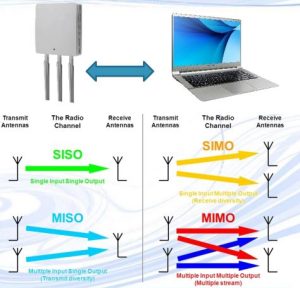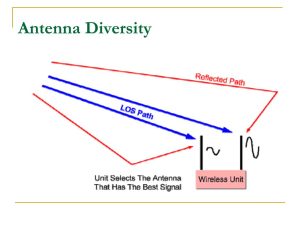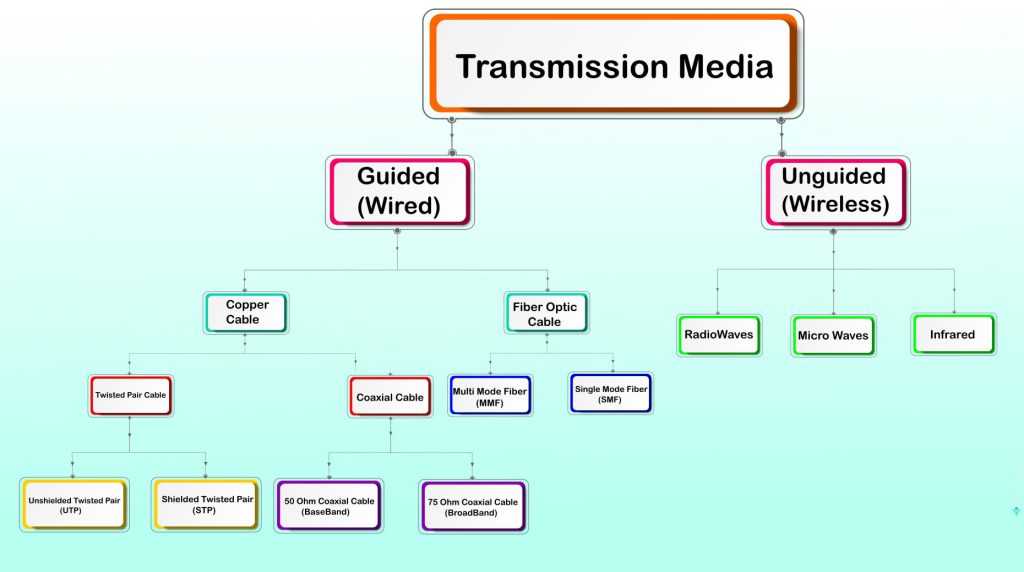The susceptibility of wireless communication systems to various types of fades is truly befuddling. These fades can wreak havoc on the quality of received signals, leaving them severely degraded. Fortunately, there are techniques in place to combat these issues and improve reception.

One such technique that has arisen is antenna diversity. By utilizing multiple antennas at both the transmitter and receiver ends, fading can be mitigated and signal quality improved. But wait, there’s more! Time diversity is another common scheme involving transmitting information repeatedly at different intervals to reduce errors caused by fade.
And if that wasn’t enough to boggle your mind, space diversity takes things even further with multiple antennas positioned in different locations capturing signals from various paths for enhanced performance. This technique has proven particularly effective in urban environments where multi-path propagation effects can cause significant signal degradation due to structures like buildings getting in the way.
In short, wireless communication may seem like a simple concept but it’s far from it with all these perplexing techniques and bursty methods being employed just to ensure we get those texts through without interruption!
Antenna Diversity: Using Multiple Antennas for Improved Reception
Contents
- 1 Antenna Diversity: Using Multiple Antennas for Improved Reception
- 2 Frequency Diversity: Utilizing Different Frequencies for Improved Signal Strength
- 3 Time Diversity: Transmitting the Same Information Multiple Times at Different Time Intervals
- 4 Space Diversity: Utilizing Multiple Antennas Spread Out in Space
- 5 Pattern Diversity: Using Antennas with Different Radiation Patterns
- 6 Polarization Diversity: Using Antennas with Different Polarizations for Improved Reception
- 7 Selection Diversity: Selecting the Best Signal Path for Improved Reception
- 7.1 What exactly is selection diversity and how does it function in wireless communication?
- 7.2 Are there any advantages to utilizing selection diversity over other techniques for enhancing wireless communication?
- 7.3 And what are some potential drawbacks associated with using selection diversity?
- 7.4 How does selection diversity differ from frequency diversity?
- 7.5 Can we combine multiple approaches with Selection Diversity for better results?
- 7.6 Which types of wireless systems stand to benefit most significantly from implementing Selection Diversity techniques?
The enigmatic technique of antenna diversity has been a highly sought-after solution in the realm of wireless communication systems, with its ability to enhance reception quality proving invaluable time and again. This type of diversity permits the exploitation of multiple antennas at the receiver end, effectively mitigating issues stemming from fading or other RF impairments that often plague wireless networks. The utilization of this method can lead to a significant boost in signal strength and error reduction, thereby cementing its status as an indispensable aspect of modern mobile communication.

A plethora of antenna diversity techniques exist within wireless communication receivers for application purposes. One such methodology is pattern diversity, which entails using different antennas possessing varying radiation patterns to capture signals from diverse directions. Another widely used approach is polarization diversity, which involves making use of numerous antennas equipped with differing polarizations for simultaneous signal reception.
As we continue advancing into an era increasingly reliant on wireless connectivity across various devices, implementing antenna diversity schemes has become more crucial than ever before. Ensuring reliable performance demands enhanced signal strength and minimal errors- objectives that are achieved through harnessing this kindred technique even amidst arduous scenarios prompted by RF fade or any other form of impairment.
Frequency Diversity: Utilizing Different Frequencies for Improved Signal Strength
The concept of frequency diversity is a well-established method for amplifying the performance of wireless communication systems. This unique approach involves transmitting identical information through divergent frequencies to optimize signal strength and minimize the debilitating effects of fading. When combined with other diversification methods, such as antenna diversity and space diversity, frequency diversity stands out as an outstanding technique that elevates wireless transmission reliability and quality.
One fascinating advantage of frequency diversity lies in its uncanny ability to battle various types of fading that plague wireless systems. Take multipath fading, for instance – it occurs when signals from a transmitter reach a receiver via multiple paths with varying lengths and delays. By using distinct frequencies during each transmission, this sort of fade can be thwarted since it affects every frequency differently. Furthermore, interference caused by outside devices or weather conditions resulting in frequency selective fading can also be mitigated by applying this approach.
Implementing frequency diversification entails employing numerous transmitters simultaneously transmitting equivalent data at different frequencies – subsequently combining these received signals using an RF combiner before sending them off to the receiving end where they are demodulated then decoded back into their original form. While there exist many ways to accomplish this type of diversification (such as time or polarization), opting for frequency diversity remains one effortlessly effective way compared to others due to its simplicity.
In conclusion, incorporating diverse schemes like antenna or space alongside utilizing the power behind such an innovative tool like frequency diversification has shown great success in enhancing overall signal strength while minimizing negative connectivity impacts within any given environment where wireless communication takes place.\n\n
Time Diversity: Transmitting the Same Information Multiple Times at Different Time Intervals
Wireless communication systems boast several diversity schemes, among which time diversity is a popular one. This scheme entails transmitting the same information multiple times at different intervals to improve the quality of signal reception by combining these transmissions.
Time diversity assumes particular significance in scenarios with multipath propagation such as urban areas or indoor spaces where signals may encounter obstacles and reflect off surfaces before reaching their intended recipient. Transmitting at different times accounts for microscopic diversity, helping combat fading caused by multipath interference.
To enable time diversity implementation, transmitters must send multiple copies of the same signal with some delay between them. The delay should be long enough that each transmission experiences a slightly different channel condition but short enough that it falls within the coherence bandwidth of the channel. At the receiver end, equalizers combine these signals to extract maximum information while minimizing errors due to noise and interference.
With higher overall system capacity and improved performance compared to other types of diversities like antenna or polarization diversity, time diversity provides significant improvement in SNR. Combine this type of diversity along with others such as selection or space-time coding schemes enhances base stations’ ability to provide reliable communication over longer distances while maintaining high data rates even when dealing with challenging propagation conditions found in indoor environments or rural areas where there are fewer cell towers available per unit area due to larger wavelengths involved than their counterparts operating on higher frequencies (lower wavelength).
Space Diversity: Utilizing Multiple Antennas Spread Out in Space
The mind-boggling concept of Space Diversity involves the utilization of multiple antennas dispersed in the vast expanse of space. This technique is particularly useful when dealing with pesky signal fading that can throw a wrench into wireless communication. Fading transpires when the strength of a signal fluctuates due to factors like reflection or diffraction. By employing numerous receiving antennas, Space Diversity has the power to intensify overall signal strength and diminish large-scale fading.
One highly sought-after application of this elusive method is Multiple-Input Multiple-Output (MIMO) technology, which reigns supreme in cellular networks. MIMO systems are equipped with an array of transmitting and receiving antennas that work together to increase data rates and bolster reliability by exploiting spatial diversity. For those who prefer CDMA systems, fret not – different time instants are also utilized for each antenna to further improve performance.
But wait – how does one determine which signal path to use among all available receiving antennas? Through a mystical process known as selection diversity! The RF amplitude from each antenna is measured at its respective receiver input before being compared with other received signals; only then may we select which one boasts superior quality for transmission purposes. And if you thought things couldn’t get any more perplexing, some even go so far as utilizing antennas with different polarizations or radiation patterns in order to augment reception quality within a wireless link implementing Space Diversity techniques.\n\n
Pattern Diversity: Using Antennas with Different Radiation Patterns
Achieving diversity in wireless communication can be perplexing, but one effective technique is pattern diversity. By utilizing antennas with varying radiation patterns, this method proves particularly useful in mobile communication where single antenna signals may succumb to small-scale fading and shadowing. The use of multiple antennas transmitting redundant copies of the same information over numerous diversity branches ensures signal integrity.
However, selecting different antenna radiation patterns involves various factors such as coherence bandwidth and time of the channel, spatial correlation between antennas, and polarization properties. For instance, when dealing with channels having a short coherence time but high spatial correlation between antennas, omnidirectional and directional antennas working together would provide better performance than two directional antennas alone. Similarly, polarized antennae could improve reception if polarization properties are essential for signal reception at the receiver end due to reflection from buildings.
Implementing pattern diversity requires merging multiple copies of received data into a coherent signal that maximizes overall performance through combiners weighing each copy based on relative quality determined by training sequence. This results in lower error rates and higher throughput compared to transmitting only one copy without any redundancy or diversification techniques.
To sum up; pattern diversity utilizes diverse branches with distinct antenna radiation patterns to transmit redundant data over dynamic channels affected by small-scale fading and shadowing effects. It offers an effective means for improving wireless communication performance in challenging environments where traditional methods fall short on their own.
Polarization Diversity: Using Antennas with Different Polarizations for Improved Reception
The concept of antenna diversity has been a perplexing one in the field of wireless systems, as it bursts forth with the potential to improve communication quality. In order to combat signal fading caused by small-scale fading and frequency-selective channels, multiple antennas are required – each endowed with unique characteristics. One such type is polarization diversity, which employs antennas with different polarizations.
Polarization refers to the orientation of electric fields within an electromagnetic wave. Transmitting or receiving signals can be accomplished through the use of antennas designed with differing polarization orientations like horizontal or vertical ones. This allows for varied signal fading on each antenna element due to Rayleigh fading and helps enhance overall signal-to-noise ratio.
Figure 1 below illustrates two antennas positioned at right angles from one another and spaced apart at a distance. When flat fading channel conditions arise due to multipath interference or noise sources, one antenna may experience this more acutely than the other owing to its distinct polarization orientation. By amalgamating both received signals using appropriate algorithms at the receiver end, better performance can be attained than if only one antenna was employed for reception purposes alone.
Selection Diversity: Selecting the Best Signal Path for Improved Reception
Selection Diversity, a technique that can improve the performance of wireless communication systems, is truly remarkable. It enables the selection of the best signal path from multiple available paths to transmit information, making it an ideal solution for fading conditions where rapid amplitude fluctuations occur due to uncorrelated fading.
The basic concept behind Selection Diversity is simply breathtaking and can be illustrated in a block diagram showcasing two antennas connected to a receiver. As information flows through the wireless channel, both antennas receive it and are compared based on their respective signal-to-noise ratios (SNRs). The receiver then makes a decision to select only one antenna with the highest SNR for further processing – unbelievable!
What sets Selection Diversity apart from other diversity techniques such as antenna or frequency diversity is its ability to provide high-speed data transmission even under deep fades. By selecting only one antenna at a time, decorrelation between signals transmitted by separated antennas can be achieved resulting in improved system performance beyond imagination!
What exactly is selection diversity and how does it function in wireless communication?
Selection diversity, my friend, is a technique that’s been designed to enhance signal reception through the selection of the best signal path available out of multiple paths. It works by continuously monitoring the quality of signals received from different paths and then choosing the one with the highest quality at any given time.
Are there any advantages to utilizing selection diversity over other techniques for enhancing wireless communication?
Indeed there are! Selection diversity has several benefits compared to other techniques such as antenna or space diversity. Firstly, it’s easier to implement due to requiring less hardware. Secondly, it performs exceptionally well even in areas where other methods fail miserably.
And what are some potential drawbacks associated with using selection diversity?
Well…if you’re asking me about disadvantages, I would say that this approach may not be effective when situations demand rapid changes in signal paths. Additionally, introducing data transmission delays could be another downside.
How does selection diversity differ from frequency diversity?
That’s a great question! Frequency Diversity uses varying frequencies while transmitting identical information in order to maximize signal strength; whereas Selection Diversity chooses one optimal path among many possibilities based on real-time analysis.
Can we combine multiple approaches with Selection Diversity for better results?
Absolutely! Combining diverse strategies like Antenna Diversity, Space Diversity, and Time Diversity increases our chances of receiving high-quality signals during wireless communication.
Which types of wireless systems stand to benefit most significantly from implementing Selection Diversity techniques?
Any system relying on wireless communication operating within an environment containing numerous signal pathways and suffering from interference or fading can benefit immensely from employing these tactics – think cellular networks along with satellite-based or Wi-Fi networks.


